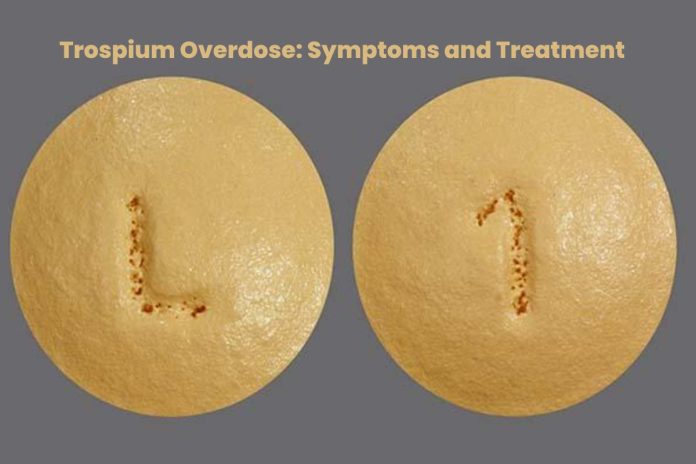Trospium is a medication used to treat overactive bladder (OAB). OAB is a condition that causes the bladder to contract involuntarily, leading to frequent urination, urgency, and, sometimes, incontinence. Trospium works by relaxing the bladder muscles, which helps reduce these symptoms.
Trospium is available as a tablet and an extended-release capsule.
In addition, trospium can cause side effects, such as dry mouth, constipation, and blurred vision.
These side effects usually are mild and go on their own. However, if you experience any side effects that are bothersome or do not go away, talk to your doctor.
Table of Contents
How does it work?
- Trospium is an anticholinergic medication.
- Anticholinergics block acetylcholine action, a neurotransmitter that causes the muscles in the bladder to contract.
- By blocking the action of acetylcholine, trospium helps to relax the muscles in the bladder, which helps to reduce the symptoms of OAB.
Trospium uses
Trospium is a medication used to treat overactive bladder (OAB). OAB is a condition that causes the bladder to contract involuntarily, leading to frequent urination, urgency, and, sometimes, incontinence.
it works by relaxing the bladder muscles, which helps reduce these symptoms.
Here are some of the uses of trospium:
- To treat overactive bladder (OAB)
- To reduce the frequency of urination
- To minimize the urgency of urinating
- To reduce the amount of urine leakage
- To get a better quality of life for people with OAB
It is a safe and effective medication for the treatment of OAB. However, it is essential to talk to your doctor about the risks and benefits of trospium before taking it.
Here are some of the risks and side effects of trospium:
- Dry mouth
- Constipation
- Blurred vision
- Headache
- Dizziness
- Fatigue
- Rash
- Allergic reaction
If you experience any of these side effects, talk to your doctor. It should not use by people with certain medical conditions, such as:
- Narrow-angle glaucoma
- Urinary retention
- Kidney or liver problems
- Heart problems
- Glaucoma
- Prostate problems
It can also interact with other medications, so talking to your doctor before taking it is essential.
If you are considering taking trospium, talk to your doctor about the risks and benefits.
However, it can be a helpful treatment for OAB, but knowing the potential side effects is essential.
Dosage and administration
- Trospium is available as a tablet and an extended-release capsule.
- The usual dose of trospium is 5 mg twice a day.
- it can take with or without food.
- It is essential to take trospium as directed by your doctor.
Side effects
It can cause side effects, such as:
-
- Dry mouth
- Constipation
- Blurred vision
- Headache
- Dizziness
- Fatigue
- Rash
- Allergic reaction
If you experience any side effects from it, talk to your doctor.
Precautions
- It should not used by people with certain medical conditions, such as:
- Narrow-angle glaucoma
- Urinary retention
- Kidney or liver problems
- Heart problems
- Glaucoma
- Prostate problems
- Trospium can also interact with other medications, so talking to your doctor before taking it is essential.
Storage and disposal
- Store trospium at room temperature in a cool, dry place.
- Keep trospium out of reach of children and pets.
- Do not flush the trospium down the toilet or pour it down the drain.
- Talk to your pharmacist about how to dispose of trospium safely.
Overdose
Trospium is a medication used to treat overactive bladder (OAB). It is a prescription medication and should only take as directed by your doctor.
If you take too much trospium, you may experience an overdose.
Symptoms of a trospium overdose can include:
- Dry mouth
- Constipation
- Blurred vision
- Headache
- Dizziness
- Fatigue
- Rash
- Allergic reaction
- Slow heart rate
- Low blood pressure
- Difficulty breathing
- Seizures
- Coma
If you feel you or someone you be familiar with has overdosed on trospium, immediately call your local poison control center.
Do not try to make the person vomit or give them anything to drink.
If you have overdosed on trospium, you may need to take it to the hospital for treatment. Treatment for a trospium overdose may include the following:
- Activated charcoal to absorb the medication
- Gastric lavage to empty the stomach
- IV fluids to help flush the medication out of the body
- Medications to treat the symptoms of the overdose
If you have overdosed it, seeking medical attention right away is essential. With timely treatment, most people make a full recovery.
Here are some tips to help prevent a trospium overdose:
- Only take it as directed by your doctor.
- Do not take more trospium than prescribed.
- Keep it out of the reach of children and pets.
Conclusion
- It is a medication used to treat overactive bladder (OAB).
- Trospium is effective in reducing the symptoms of OAB, but it can also cause side effects.
- Before taking it, you must speak to your doctor about the risks and benefits of trospium.



